This year marks the 120th anniversary of the first American V-twins
When it comes to historically significant motorcycle brands, Orient isn’t at the top of many people’s lists. However, it was the first American marque to start series production as far back as 1899. Created using single-cylinder engines from French brands Aster and DeDion mounted in reinforced bicycle frames, the Orient’s popularity grew quickly, largely thanks to having no competition. But when competition inevitably came two years later, Orient unveiled a new prototype V-twin engine aimed at keeping the brand at the top of the heap.

The first V-twin design on record: Daimler’s 1889 creation
Around the same time, speed-obsessed Glenn Curtiss built his first motorcycle in 1901, founded the G.H. Curtiss Manufacturing Company the following year, and put his first 347cc single-cylinder four-stroke motorcycle into production under the name Hercules. A year later, he was the first rider in America to reach a lightning speed of more than 100km/h.
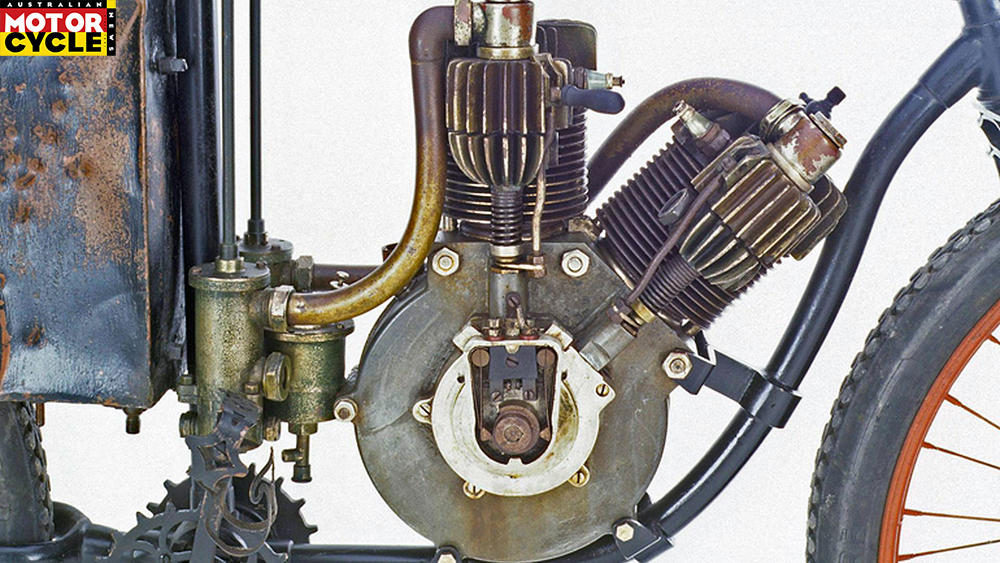
The 1901 Orient V-twin prototype
In his search for more speed, Curtiss increased the displacement of his engine by mounting a second cylinder on a joint crankcase which led to the development of America’s first V-twin, a 42.3ci (694cc) 60-degree layout that weighed only 27kg and was just 40cm high. He finished it in 1903 and put it into production immediately, officially making it America’s first production V-twin. A few months later Orient’s V-twin was also released, and not only did Curtiss beat Orient to the V-twin punch but it also had far superior performance.
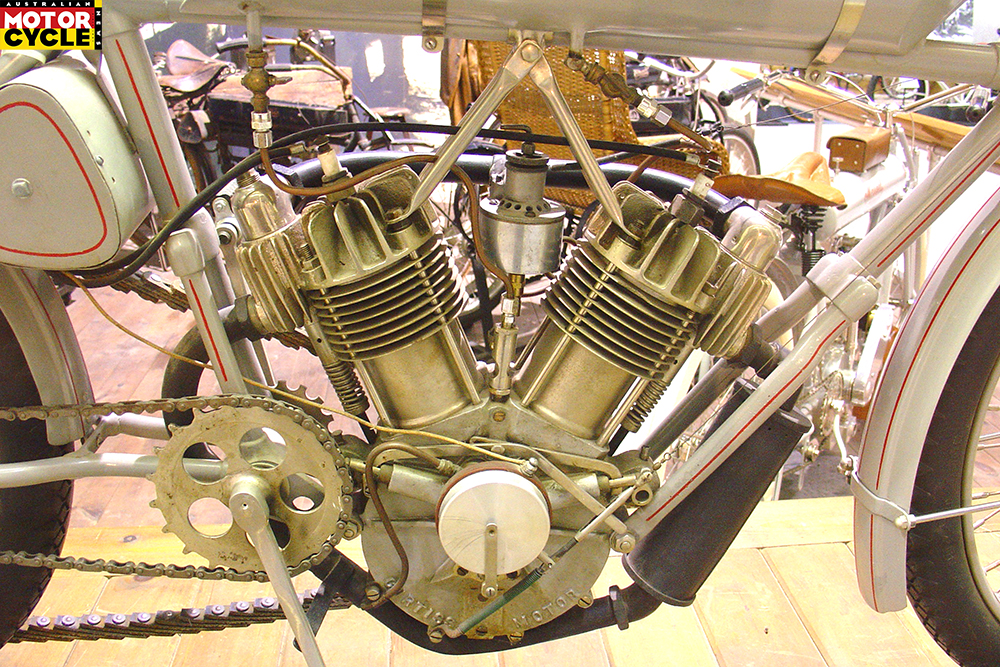
Curtiss holds the honour for producing America’s first V-twin
The V-twin becoming America’s most popular engine configuration was also largely due to Curtiss. As well as winning America’s first hillclimb road race and many events afterward, he set a swag of speed records thanks to its superior power and speed compared to the few single-cylinders on the market at the time. The V-twin concept was seen as the most successful engine configuration in America.
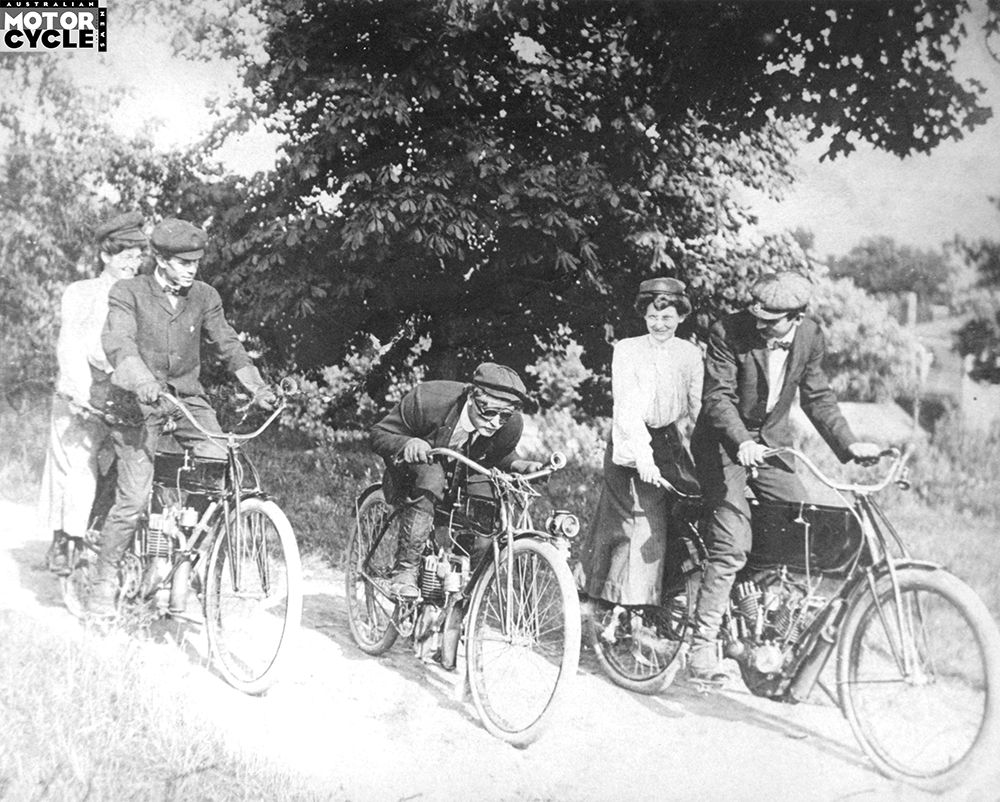
Far right: Glenn Curtiss and his wife enjoying the V-twin’s delights
And while Curtiss would eventually shift his interests and money to aviation, in January 1904 he broke the 10 mile (16km) world speed record with an average speed of 107.68km/h on Ormond Beach in Florida.
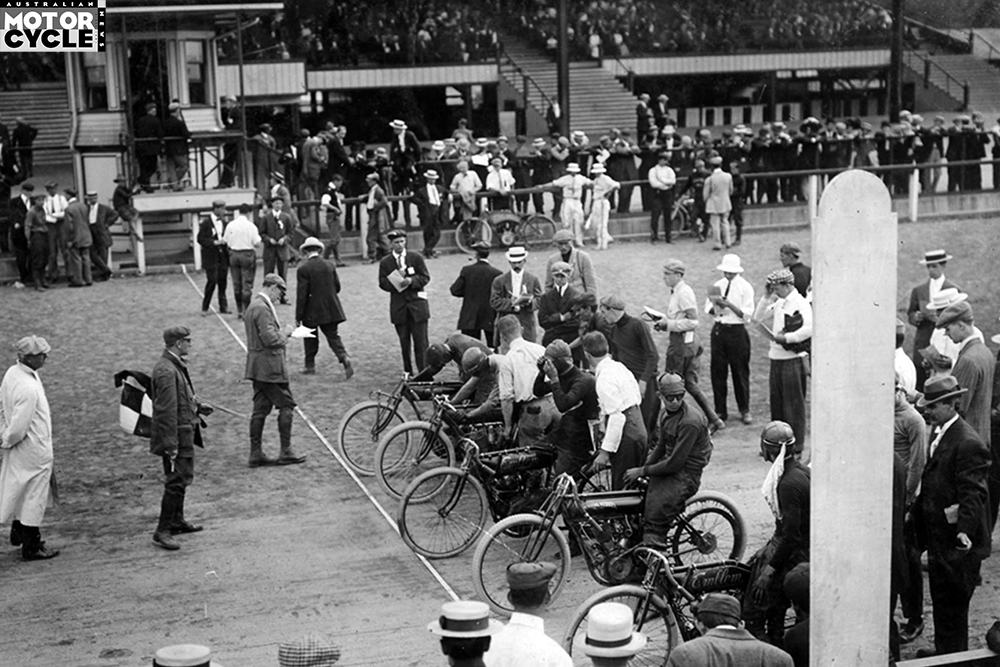
How’s that for a front row? Lining up for some action at Ontario in 1911
The followers
Metz was also an early V-twin manufacturer. In 1905 the Metz racer appeared with a vertical rear cylinder, while the front cylinder was used as part of the frame and connected to the front down tube. Geer also introduced two V-twin models in 1905 – air- and water-cooled versions which both produced just 3.7kW (5hp). It was America’s first water-cooled V-twin.
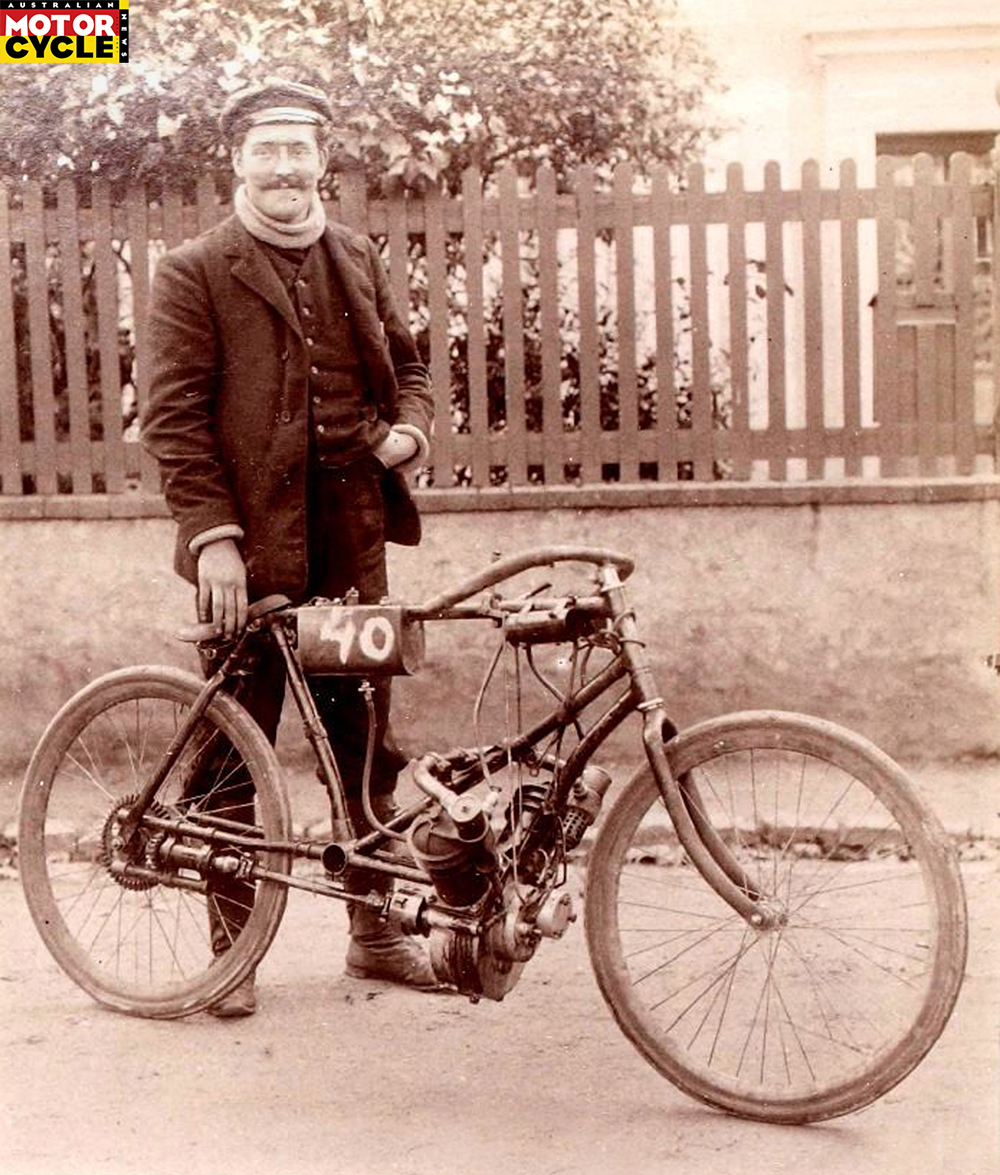
The 1902 Moto-Cardan
Meantime, Curtiss had found a major on-track competitor in Indian. Founded in 1901, Indian was superior in all races that Curtiss did not participate in.
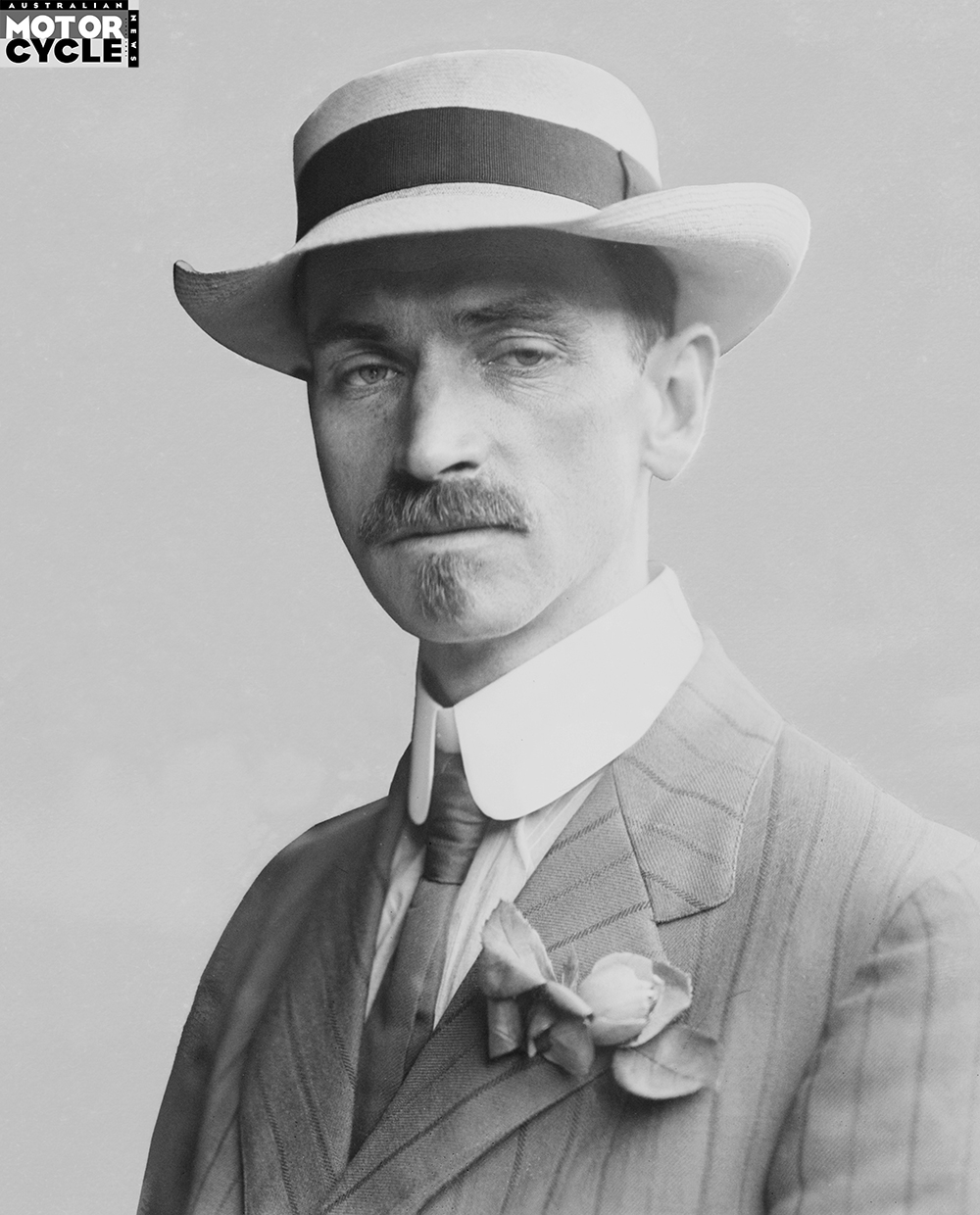
Curtiss in 1909, during a time when Indian was becoming a key on-track competitor
Many first editions of famous American races were won by Indian, but it would take until 1906 before Indian built its first V-twin prototype which went into production in 1907. With a displacement of 39ci (633cc) and a vee angle of 42 degrees, it grew to 60.32ci (988cc) in 1909 to set a new capacity standard at the time.

M.M Motorcycles exhibit at the 1909 Boston Auto Show
In 1911, Indian became the first non-British brand to win a TT at the Isle of Man, with Oliver Godfrey leading home an all-Indian podium in the blue-chip Senior TT.
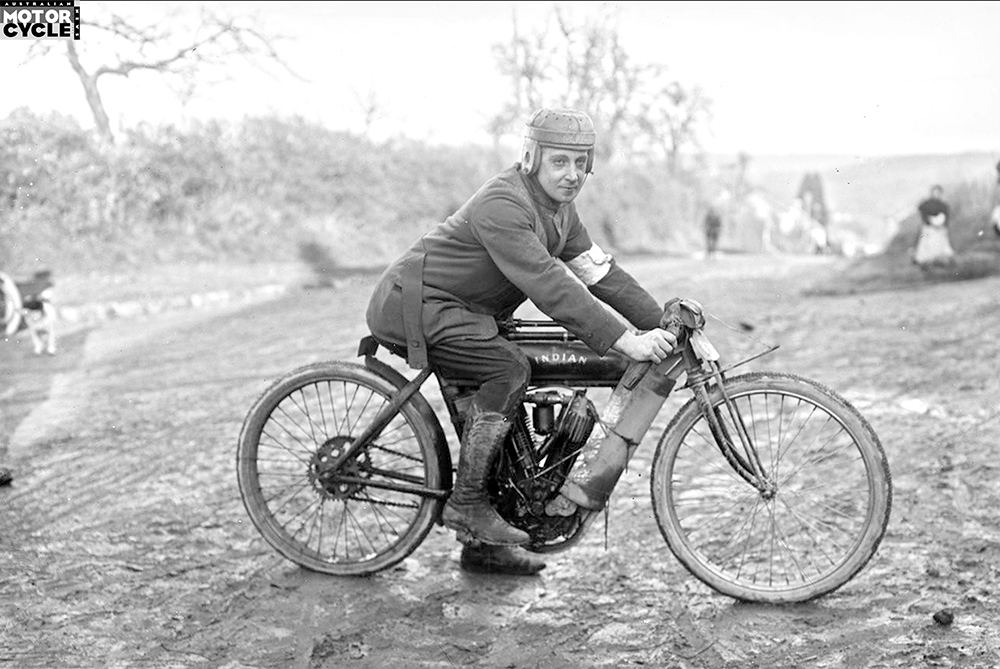
The 61ci Indian in 1911
Reading-Standard was the first American motorcycle company to build a side-valve engine and, two years later in 1908, it introduced its first V-twin. It was a 61ci (1000cc) offering that proved popular among amateur racers in the growing board track scene.
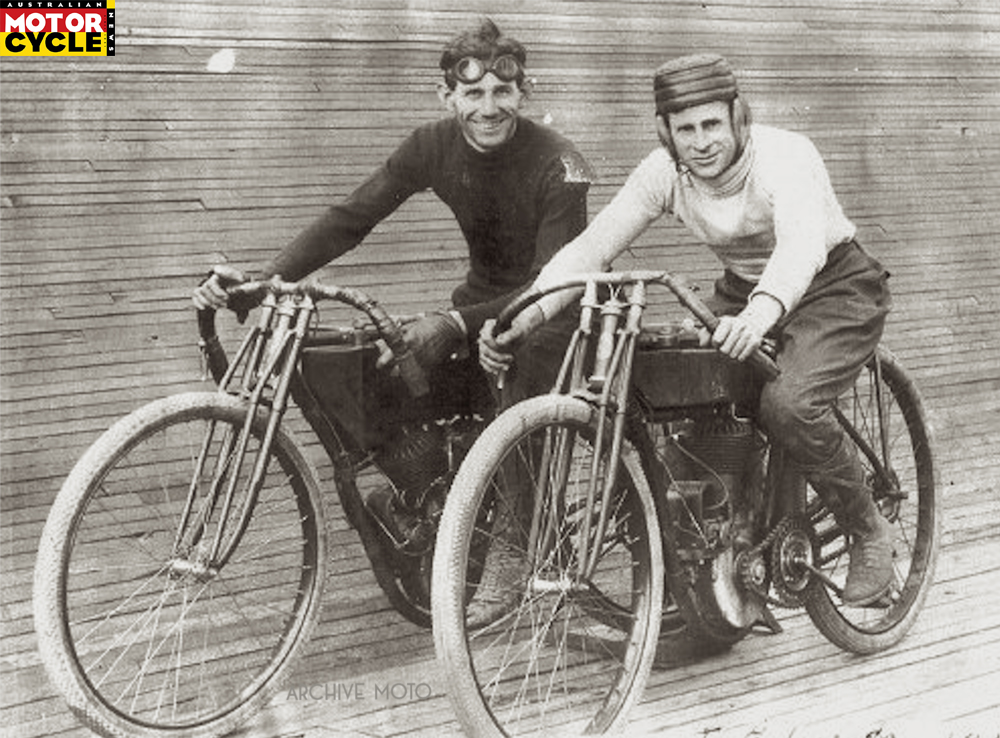
Erle Armstrong onboard his frequently victorious yellow Flying Merkel twin
Harley-Davidson’s first V-twin prototype appeared in 1907, but it wasn’t until 1911 that the company’s first V-twins went into production, available in 49.48ci (811cc) and 60.32ci (988cc) versions. Between 1903 and 1913, H-D had a strict no-racing policy, but reversed that edict from the 1914 season which resulted in a steady development of its V-twins.
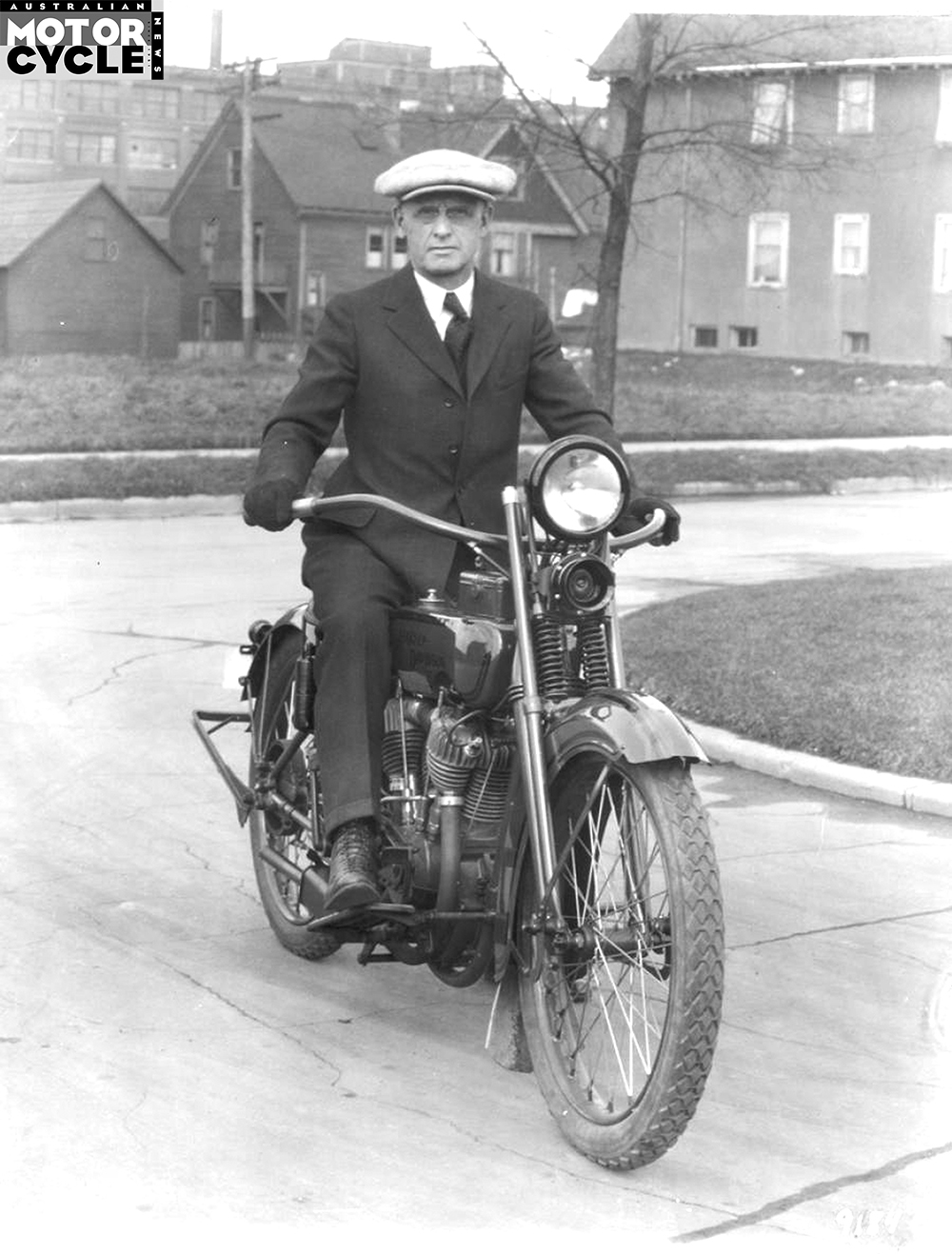
In 1911 Harley’s first V-twin went into production
Via several impressive hillclimbers, this development eventually culminated in the famous 1000cc Model E Knucklehead V-twin in 1936. It was the Motor Company’s first production V-twin with overhead valves and the ancestor of all Milwaukee-made Big Twins that followed.

HD Model DAH 750cc factory hillclimber 1929
Technology catches up
The year 1909 saw the introduction of two Merkel-Light V-twins. Marketed as Flying Merkels, there were 53.92ci (884cc) and 61ci (1000cc) versions. Merkel, founded in 1902, was one of the first American motorcycle manufacturers to use a purpose-built loop frame instead of a reinforced bicycle frame. It meant the engine could be mounted much lower in the frame, and it was a strategy that was quickly copied by other American brands. In 1907 Merkel introduced a telescopic front fork and swingarm rear suspension on its production singles, which was a first, as was the V-twin’s kickstarter in 1915. But Merkel didn’t win contracts to build military motorcycles, unlike rivals Harley-Davidson, Indian and Excelsior, and closed its doors the same year.

Pope produced its first V-twin in 1911, after having international success with the production of bicycles and, less so, cars. Pope wanted to benefit from the publicity of racing, so developed a 61ci (1000cc) V-twin suitable for both racing and street use. Delivering a power output of 10kW (14hp), it was one of the first American production bikes to boast overhead valves.
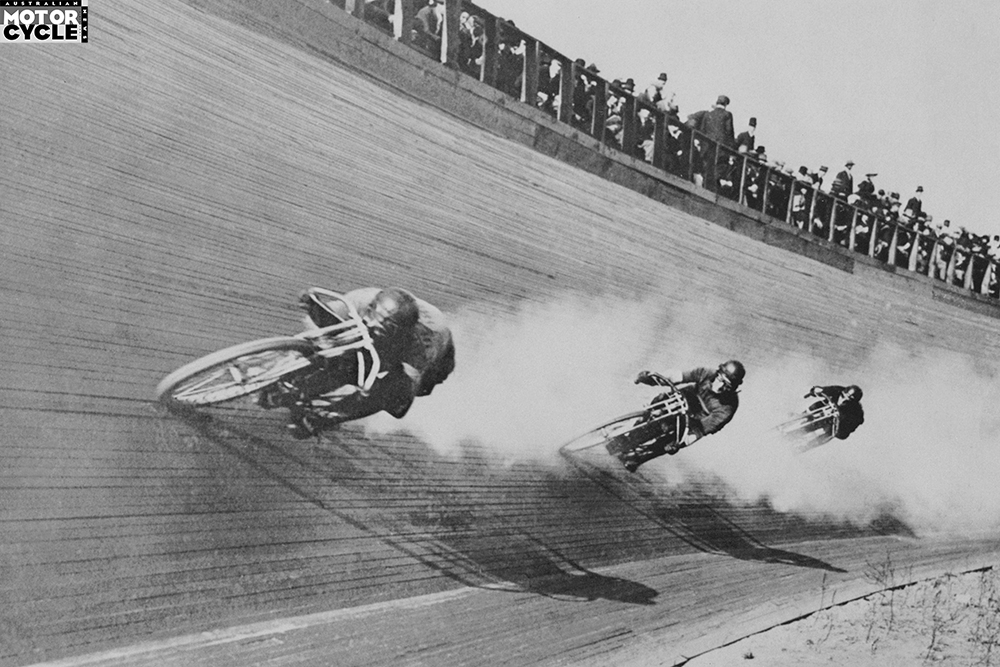
Board-track racing in 1912 when it was a huge discipline
In 1914 a sportier Pope model was released, based on Pope’s first factory racer. However, it wasn’t a match for the works machinery of Harley and Indian and the company withdrew from racing. When America entered the first World War, Pope greatly reduced the production of motorcycles in favour of manufacturing machine guns for the war effort. This turned out to be much more profitable for Pope, which stopped motorcycle production altogether in 1918.
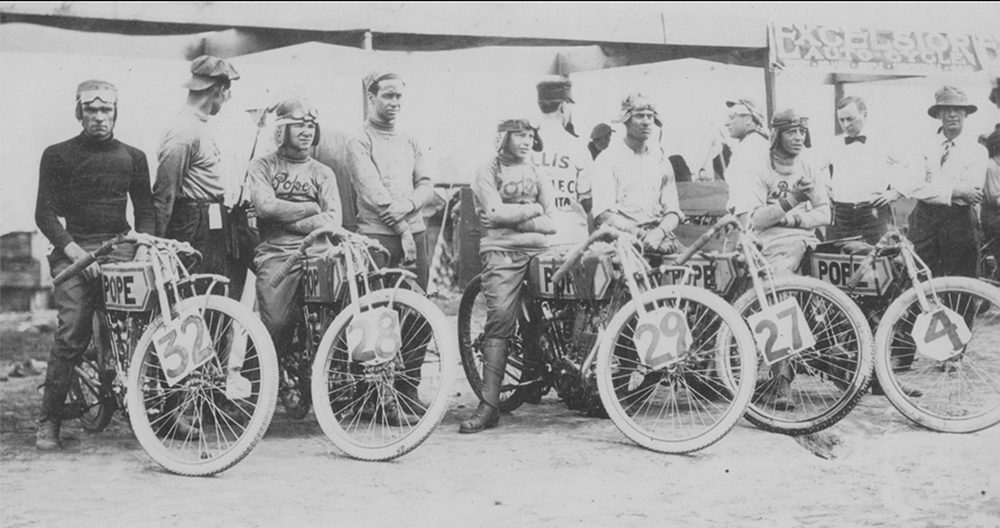
Pope motorcycle early 1914 Dodge City racing team motorcycle
The big three
At the end of 1910, Excelsior also put its first V-twin motorcycles into production, equipped with a 50ci (819cc) or a 61ci (1000cc) V-twin engine. Indian, Harley and Excelsior were by far the three largest American motorcycle manufacturers of the early 20th century. The new Excelsior formed the basis for the firm’s first factory racer, and was so successful that Indian immediately commissioned the development of a 61ci (1000cc) eight-valve V-twin racer. According to Indian, its eight-valve engine was good for a top speed of 160km/h during the 1911 Senior TT, which the British motorcycle industry openly questioned. To prove it, Indian factory rider Jake DeRosier performed a timed speed run down the promenade in Douglas on the Isle of Man. Time keepers were called in and, after the run, many onlookers were stunned that this machine actually managed to reach the magic ‘ton’. Harley also developed an eight-valve engine during that period where many American speed records were broken.

Excelsior 61ci V-twin motorcycle, 1920s
From 1910, many smaller American engine manufacturers also started V-twin production. That was because two major American engine manufacturers, Thor and Spacke, also offered V-twin engines to other motorcycle and even engine manufacturers during that period, after which these manufacturers sooner or later developed their own.

Supply and demand
Thor began as the Aurora Automatic Machinery Company in Aurora, Illinois. In October 1902 Aurora began producing engines for Indian, which lasted until March 1907 until the latter created its own production facilities. Part of the Indian deal was that Thor could use the engines or offer them to other engine manufacturers, which led to the first Thor motorcycle in 1903 – basically a copy of the first Indian.
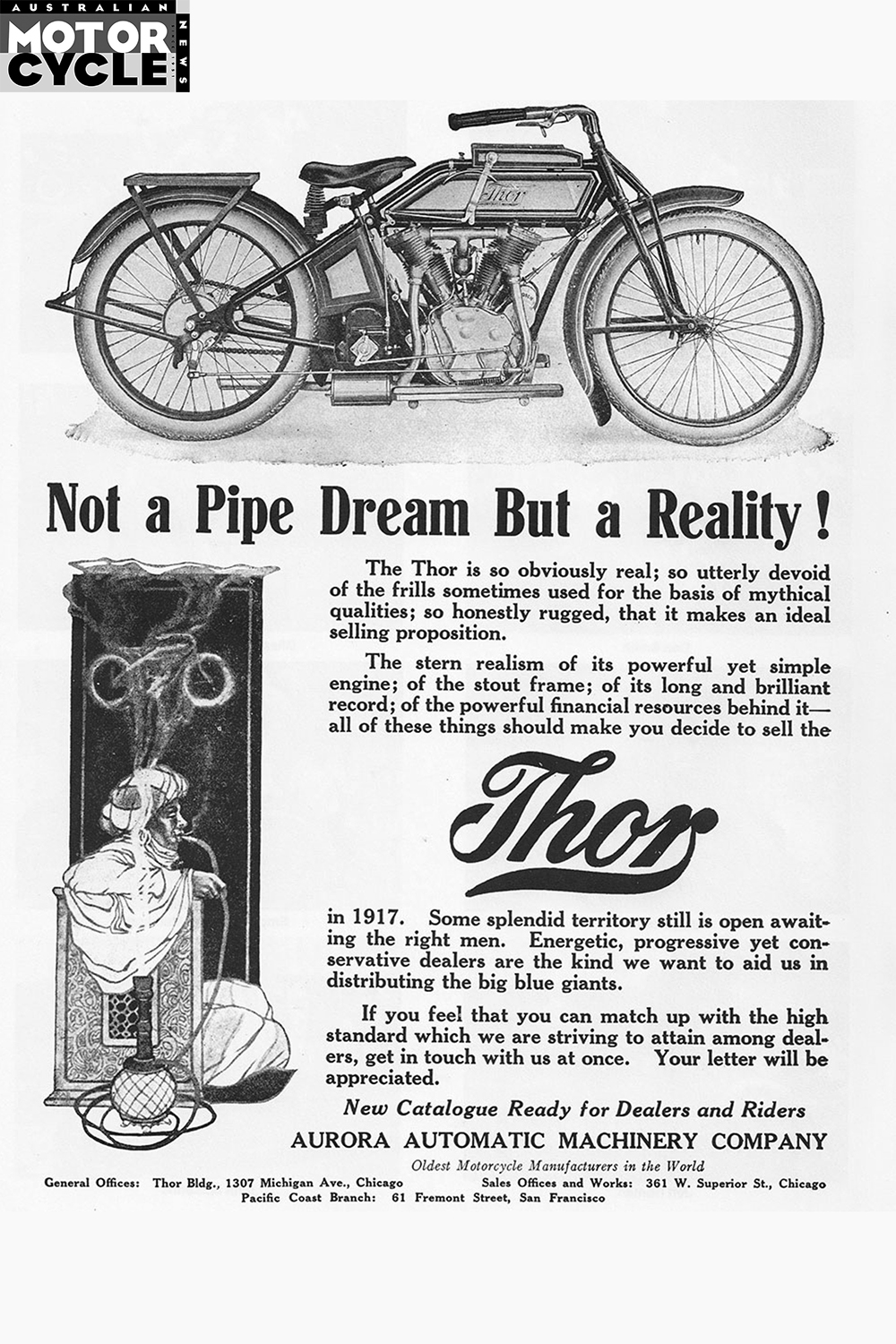
1916 Thor Motorcycle advertisement
In 1908, Thor built its first V-twin, still leaning heavily on Indian technology, but released its own V-twin in 1911, mounting a pair of its singles onto a common crankcase. In 1912 this twin was succeeded by a completely new 61ci (1000cc) design which, according to Thor, was “the boss of road and track”. In 1914, a 76.25ci (1191cc) version appeared and Thor sold these large-capacity V-twin engines to other manufacturers such as Minneapolis, Moto-Racycle, America, Warwick, Manson, Light Thor-Bred, Thoroughbred and Reading-Standard. As a result, Thor also played a major role in the spread of the V-twin concept in America. Spacke also built V-twin engines that were used by many different brands.
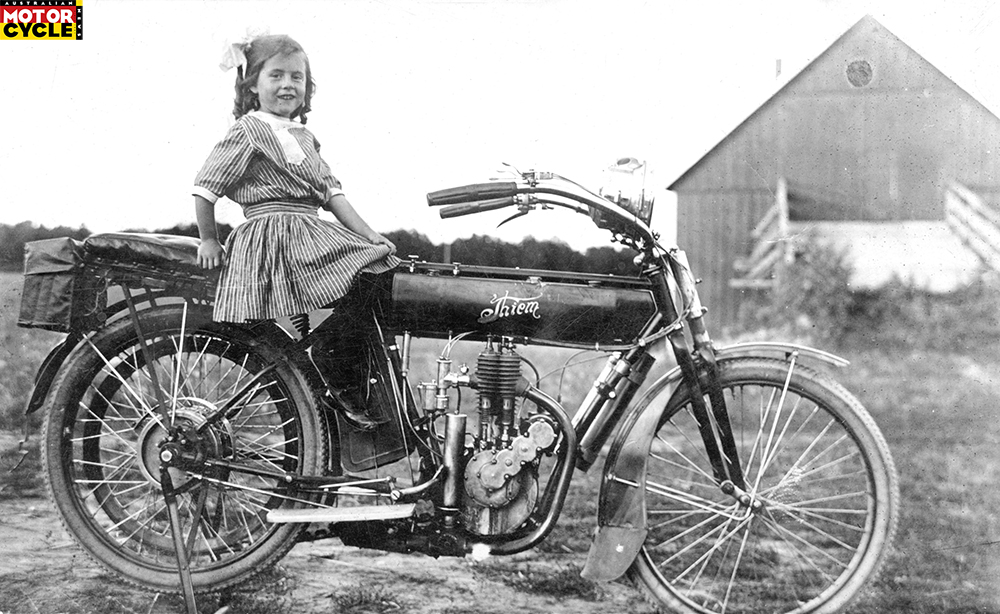
1913 Minneapolis V-Twin with Spacke DeLuxe engine
Value added
The most notable motorcycle of the time was the Cyclone V-twin, which was in production between 1914 and 1915. These machines were technically advanced and were manufactured by the Joerns Motor Manufacturing Company of St. Paul, Minnesota. The engine was designed by Andrew Strand, a Swedish-born automotive engineer. According to Joerns, the Cyclone engine was the first mechanical object in the history of mankind that contained parts where a dimensional accuracy of 0.001 inches was achieved. The 1000cc Cyclone V-twin had two overhead valves per cylinder that were driven by an overhead camshaft. The camshafts in turn were bevel driven, and it used very expensive self-adjusting SKF bearings. These parts alone were more expensive than the average V-twin motorcycle of another brand at the time, and is one of the reasons why Cyclones are among the most sought-after and most valuable V-twins in the States.

Cyclone V twin racer Larry Fleckenstein 1914
But the highest-capacity V-twin of that period was built by Emblem. In 1911 the New York factory introduced its first 61ci (1000cc) V-twin, which was succeeded two years later by a 76.6ci (1255cc) twin, the biggest on the market. Indian and Harley followed with 74ci V-twins (1212cc) seven and eight years later respectively. After 1917 Emblem disappeared from the American market, but the smaller 32.4ci (531cc) V-twin remained in production in Europe until 1925.
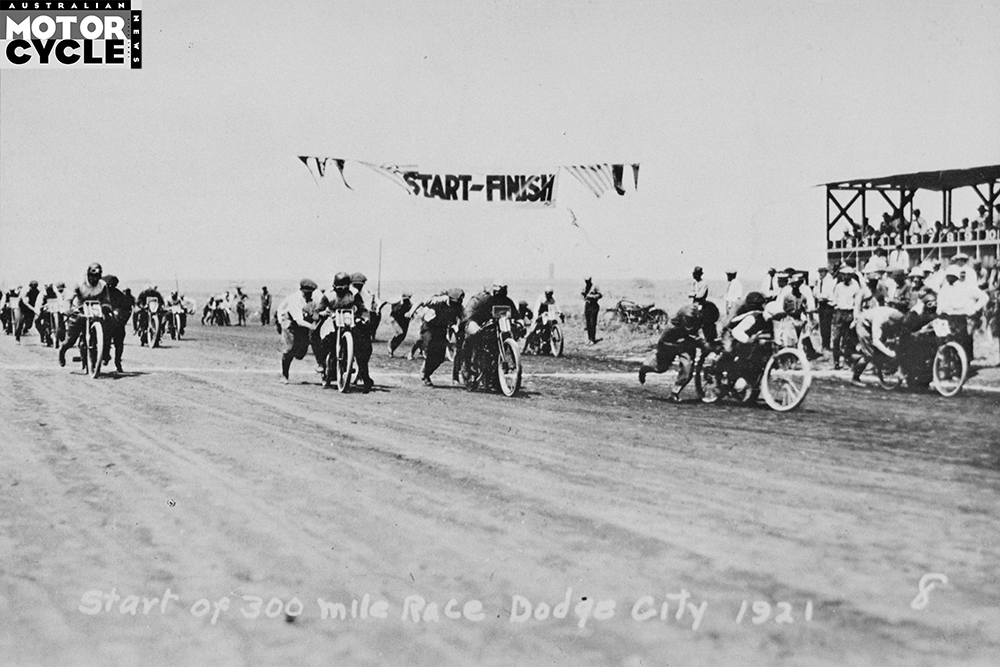
300 miles race Dodge City 1921 Paul Anderson extreme right with Excelsior 61ci V-twin works bike
The first American shaft-driven bike with a V-twin engine was built between 1912 and 1915 by Feilback Limited, which offered a chain-driven version as an option.

Feilbach 1914 Motorcycle photo early American motorcycle Milwaukee
By now, V-twins ruled American streets and circuits, reigning supreme in long-distance races and board track events – American V-twin racers were considered the most advanced motorcycles around the globe.
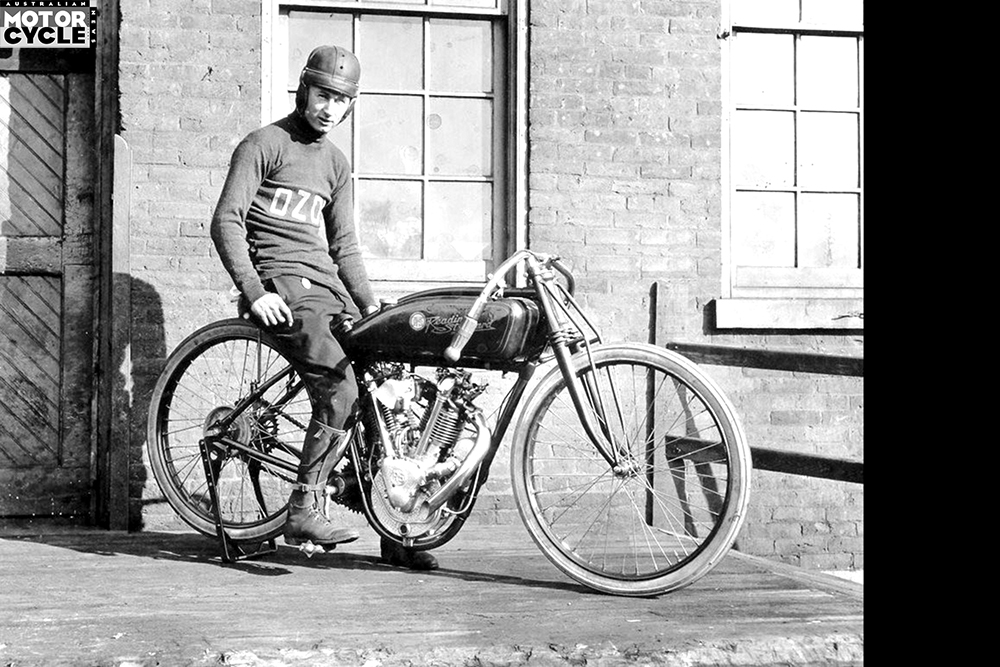
Reading Standard works racer Ray Creviston 1921 Cyclone powered bike
Capacity matters
At the end of 1919 Indian introduced the new Scout for the 1920 model year. For its time it was a very advanced motorcycle, the press even described it as “sensational”. Purposefully designed from the ground up, it was equipped with a 36.38ci (596.16cc) V-twin engine – though referred to as a 37ci (600cc) – and it was an immediate commercial and sporting success.
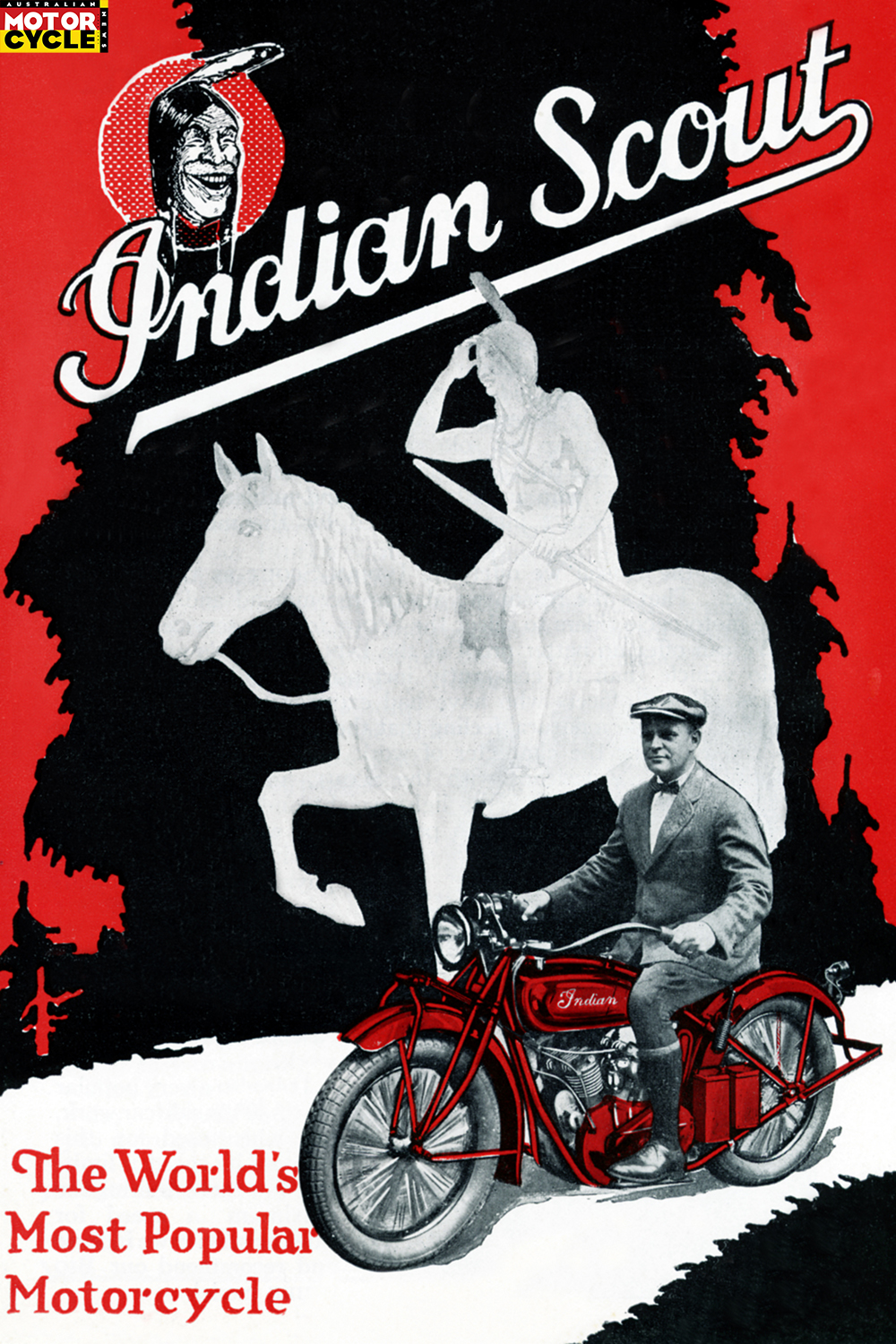
Excelsior responded very well to this and introduced its new 45ci (750cc) Super X V-twin in 1924. The new Super X became extremely popular and prompted other brands such as Harley and Indian to produce 45ci models of their own,
the latter opting to increase the Scout’s capacity to 750cc.
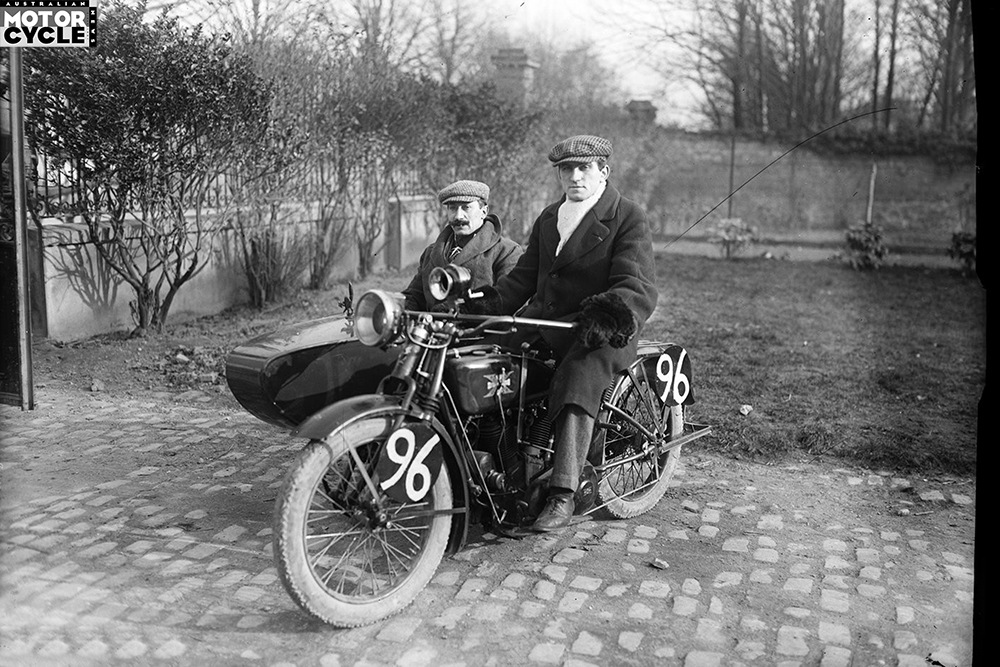
Excelsior V-twin racer Chappaz 1921 Paris-Nice
In 1929 Excelsior’s Super X models received a teardrop-shaped fuel tank with an integrated instrument cluster, which is a styling trend that remains on many American-made V-twins today. Interestingly, that tank came from the Henderson four-cylinder models, since both Henderson and Excelsior were owned by Ignaz Schwinn. In 1931, the production of Super X and Henderson stopped due to the collapsed economy after the dramatic Wall Street Crash of 1929.
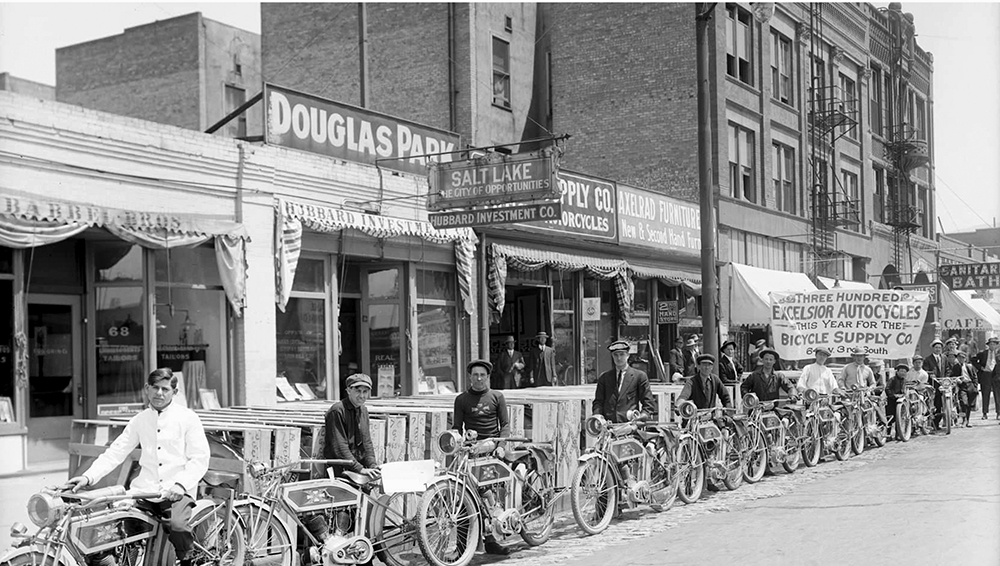
Excelsior Henderson motorcycle line up
Harley and Indian were pretty much the only American motorcycle manufacturers to survive the crash and the Great Depression that lasted until 1939. Mind you, Albert Crocker came on the market in 1936 with the 61ci (1000cc) Crocker Twin, an expensive high-powered OHV that was good for 41kW (55hp) at 5800rpm – at a time when Harleys and Indians were producing 35-odd horsepower. Croker Twins remained in production until 1942. Croker had already made a name for himself as a former Indian dealer when in the early-1930s he converted Scout engines to a 30.5ci (500cc) capacity and equipped them with overhead valves for dirt-track racing.
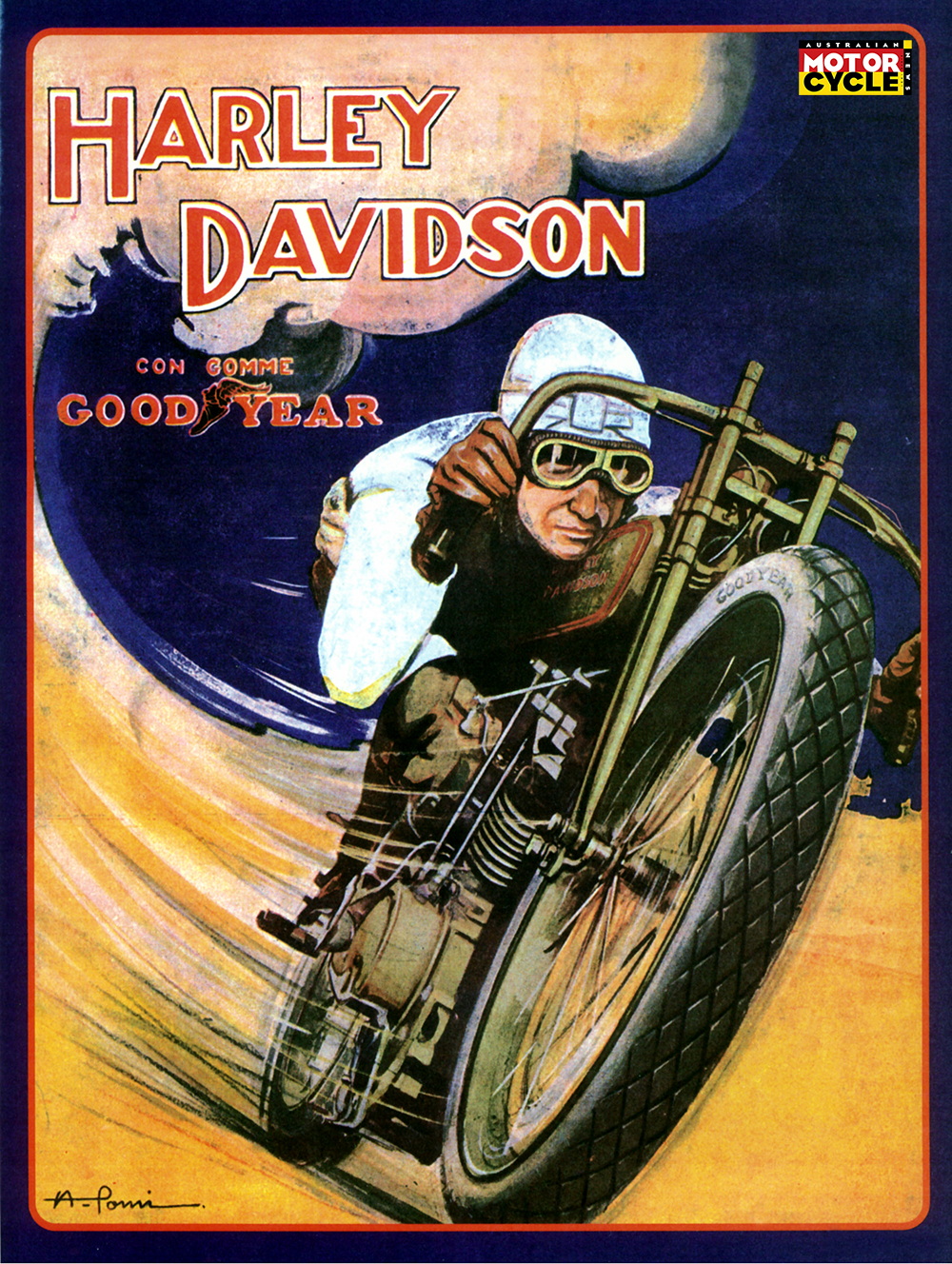
Harley Davidson 8-valve 61ci 1000cc V-twin boardtrack works racer 1920 – model raced by Davis
The Crocker V-twins remained in production until 1942, with several even delivered with a whopping displacement of 91ci (1491cc)!
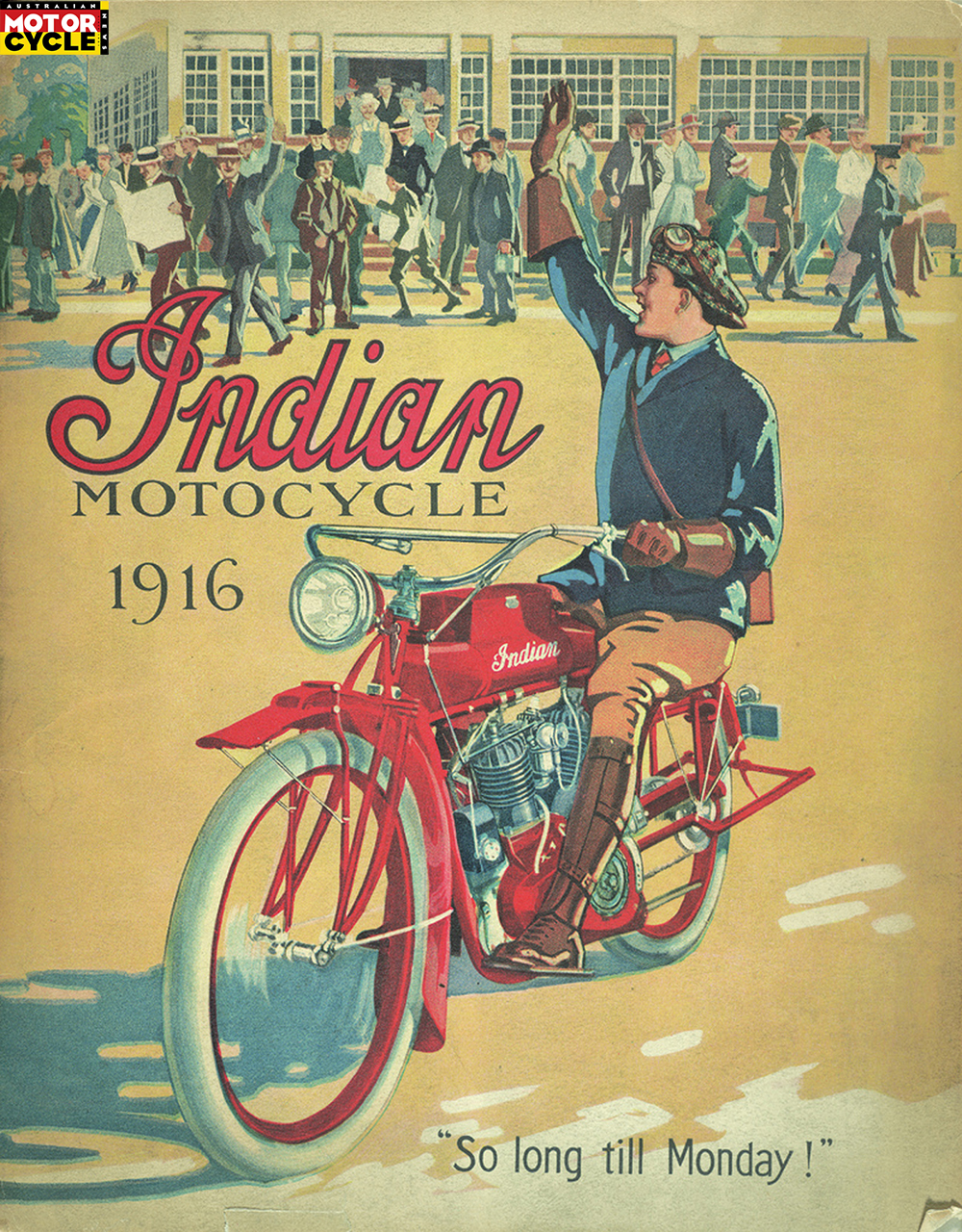
Highs and lows
In 1936, Harley made a master move and introduced the Model E and EL Knucklehead OHV, which gave the company a bright future – helped by large military orders for the 45ci (750cc) WLA and WLC during WW2. Harley kept the momentum going after the war with the release of the K-series side-valve and the Sportster OHV models in the 1950s, and its XR750 became the most successful V-twin racer ever built in the US.
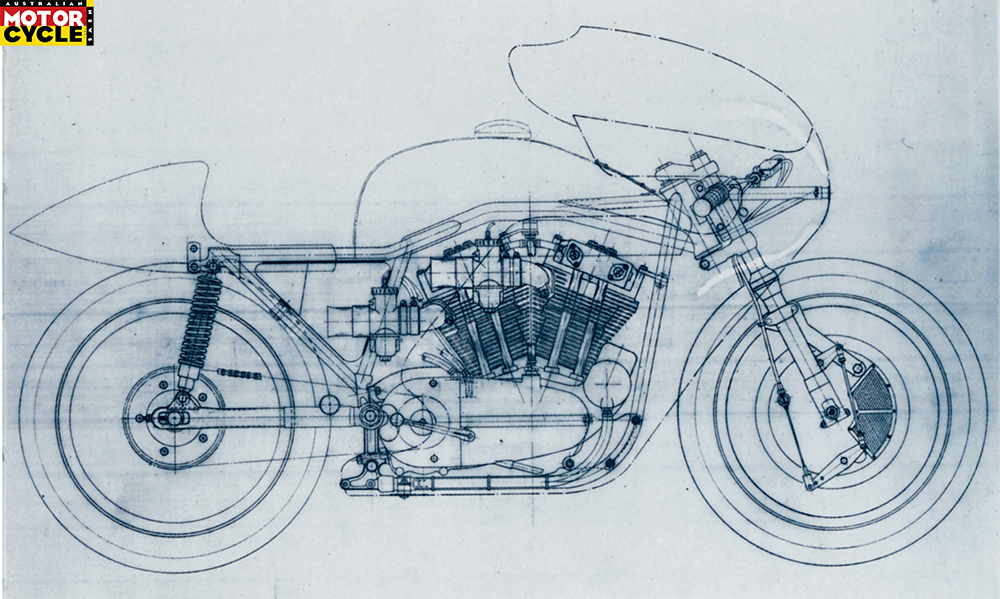
Harley Davidson XR 750 1972 alloy engine blueprint Poster 1972
Indian continued to develop the Scout and the Chief until 1953 before the curtains were eventually drawn on the American brand. In 1997 Polaris launched the Victory motorcycle brand as competition against Harley-Davidson. With a debut at Planet Hollywood and an unrivalled capacity of 92ci (1510cc), the inaugural V92C went in production in July 1998.
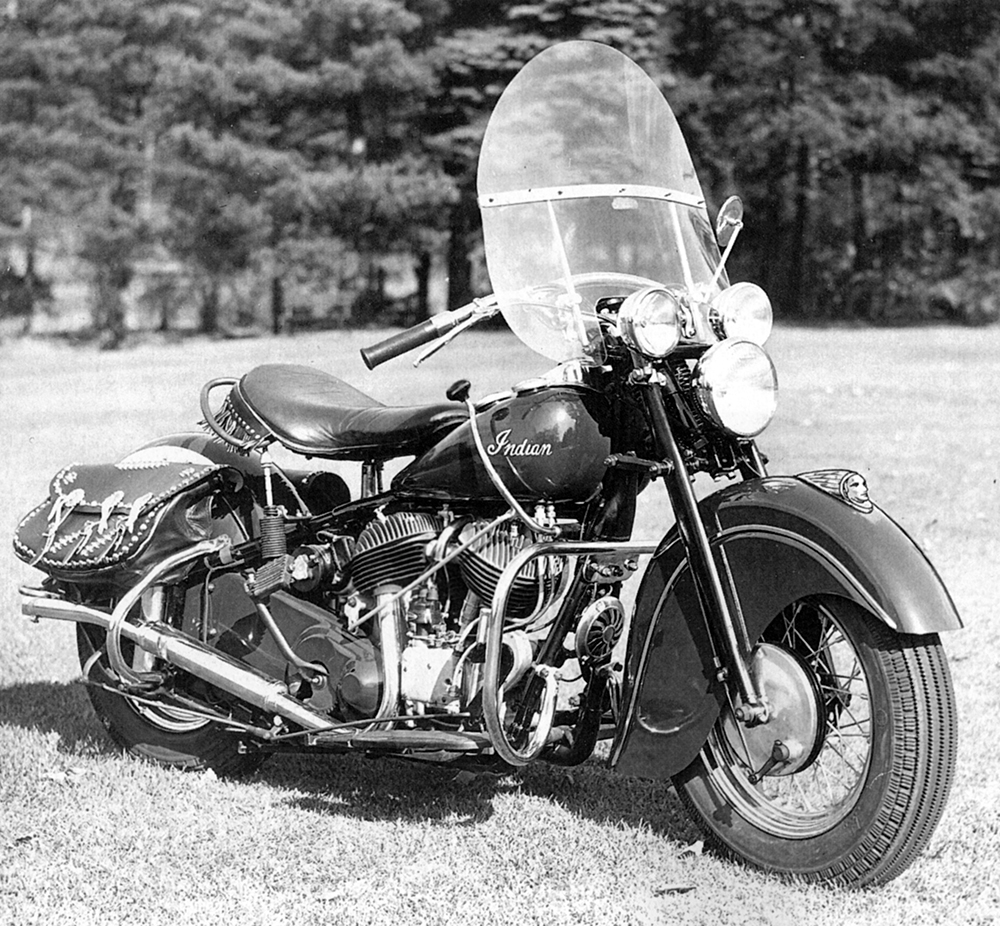
Indian 348 Big Chief Roadmaster 1948
Polaris kept several Victory models in production until 2017 before its acquisition and relaunch of Indian led to the demise of Victory Motorcycles. Motorcycling’s longest-standing rivalry was now back in business.
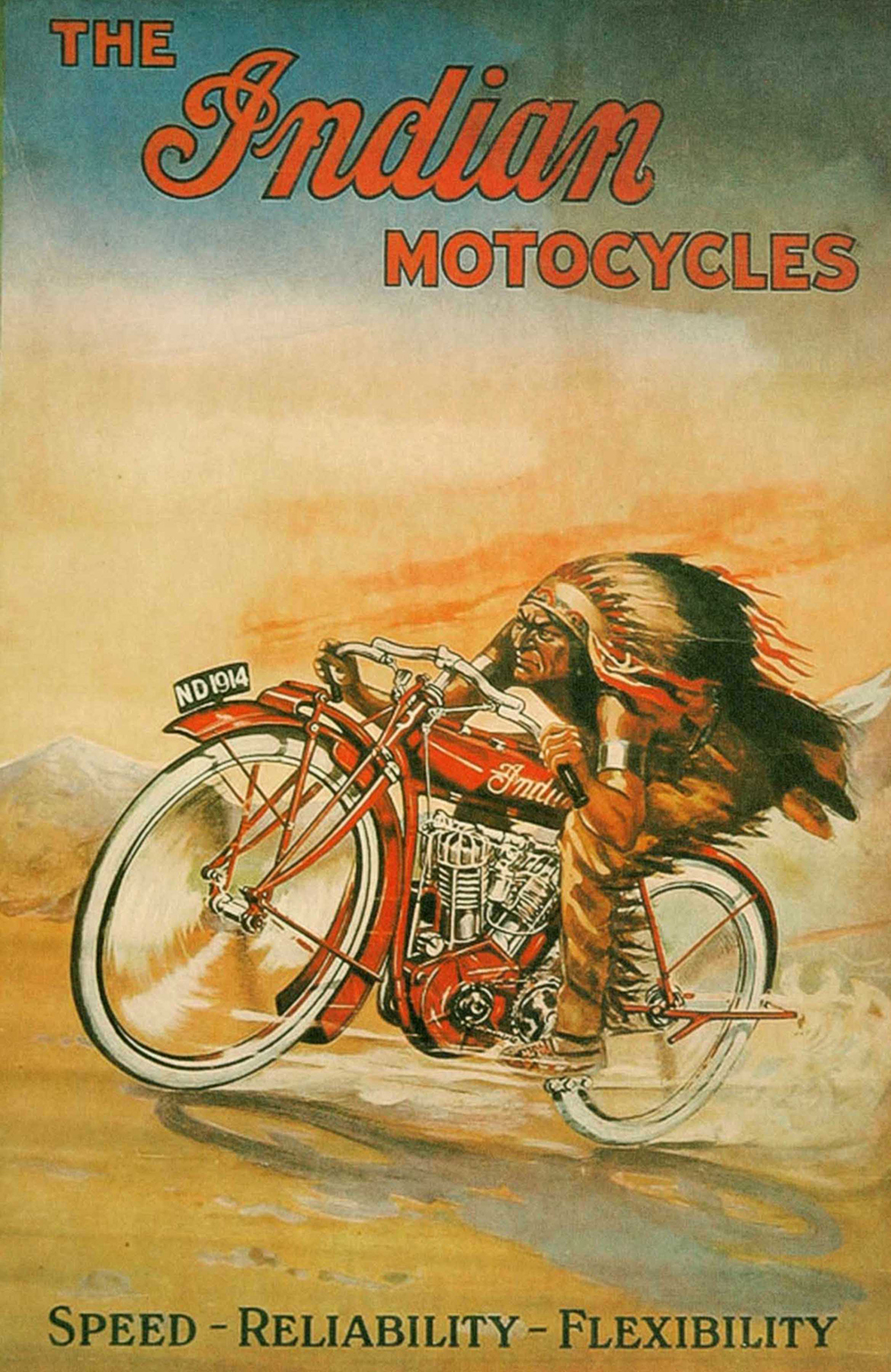
European origins
Despite being indelibly linked to American iron, the V-twin engine’s origins are in Europe
Gottlieb Daimler patented the first V-twin combustion engine in 1889. Two years later Peugeot became the first commercial buyer of Daimler’s engine, using it initially in a car and then in a motorcycle where it was mounted longitudinally in the frame.
In 1904 Peugeot built its first prototype V-twin, and its descendant was also the first European V-twin to be exported to America. It would go on to power Rem Fowler’s Norton on which he won the inaugural Isle of Man TT in 1907.

Ader 1901 patent drawing
In 1899, French company Ader patented its first V-twin, which was a far more modern design than the Daimler. The 1000cc 90º V-twin was mounted longitudinally in the Adler. Moto-Cardan also saw possibilities for this engine in 1902, opting to mount it transversely in the frame to improve cooling. Between the transverse engine and the shaft drive, the Moto-Cardan is reminiscent of today’s Guzzi V-twins.
From France, the V-twin slowly but surely conquered the rest of Europe. Peugeot, DeDion and Clement were the biggest French exporters of V-twin engines at the time. Very early British motorcycle brands that used V-twin engines were Princeps (1902), Clement-Garrard and the Hamilton Motor Company.
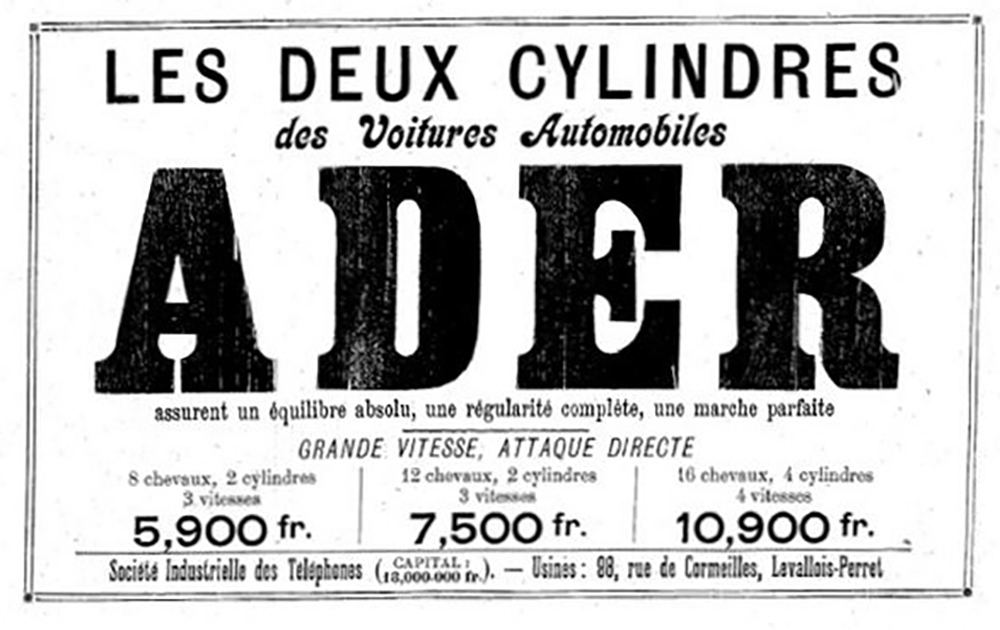
Ader 1901 twin motorcycle advertisement
Headaches
From F-head to OHV
In America, the first V-twin heads were described as F-head engines and used an overhead intake valve and a side-valve exhaust. The exhaust valve became much hotter and therefore broke more often than the intake valve.
A broken side valve causes less engine damage than a broken overhead valve, hence why side-valve engines became more popular. Initially, the intake valve was operated naturally – sucked open when the piston went down – but Indian introduced camshaft operation in 1908. Between 1900 and 1915, 95 percent of American motorcycles were equipped with an F-head engine. From 1915, the side-valve became fashionable; for Harley they remained in production until 1969.
In the 1910s, the OHVs also made more appearances. They were initially intended for racing, where the first Indian (1911) and Harley-Davidson (1916) eight-valve V-twins made life difficult for each other. Pope was one of the first to introduce overhead valves on its production V-twins in 1912, but overhead valves remained a rarity on production bikes until Harley introduced the Knucklehead Model E OHV in 1936.
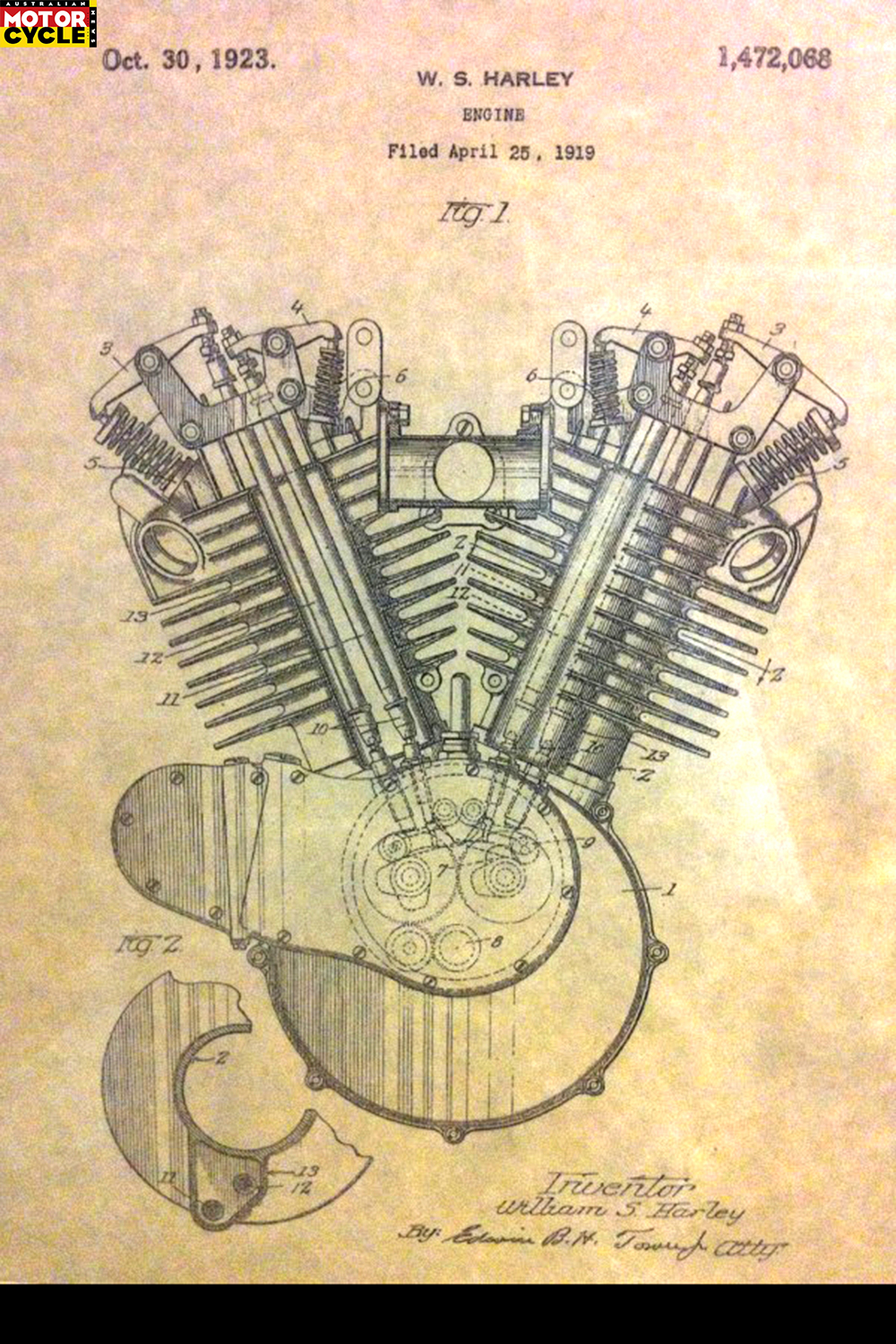
Harley Davidson overhead valve patent 1923
Words Ivar de Gier + Photography Archives A. Herl